Deheng Ye
Tencent Inc
RLogist: Fast Observation Strategy on Whole-slide Images with Deep Reinforcement Learning
Dec 13, 2022Abstract:Whole-slide images (WSI) in computational pathology have high resolution with gigapixel size, but are generally with sparse regions of interest, which leads to weak diagnostic relevance and data inefficiency for each area in the slide. Most of the existing methods rely on a multiple instance learning framework that requires densely sampling local patches at high magnification. The limitation is evident in the application stage as the heavy computation for extracting patch-level features is inevitable. In this paper, we develop RLogist, a benchmarking deep reinforcement learning (DRL) method for fast observation strategy on WSIs. Imitating the diagnostic logic of human pathologists, our RL agent learns how to find regions of observation value and obtain representative features across multiple resolution levels, without having to analyze each part of the WSI at the high magnification. We benchmark our method on two whole-slide level classification tasks, including detection of metastases in WSIs of lymph node sections, and subtyping of lung cancer. Experimental results demonstrate that RLogist achieves competitive classification performance compared to typical multiple instance learning algorithms, while having a significantly short observation path. In addition, the observation path given by RLogist provides good decision-making interpretability, and its ability of reading path navigation can potentially be used by pathologists for educational/assistive purposes. Our code is available at: \url{https://github.com/tencent-ailab/RLogist}.
Pretraining in Deep Reinforcement Learning: A Survey
Nov 08, 2022Abstract:The past few years have seen rapid progress in combining reinforcement learning (RL) with deep learning. Various breakthroughs ranging from games to robotics have spurred the interest in designing sophisticated RL algorithms and systems. However, the prevailing workflow in RL is to learn tabula rasa, which may incur computational inefficiency. This precludes continuous deployment of RL algorithms and potentially excludes researchers without large-scale computing resources. In many other areas of machine learning, the pretraining paradigm has shown to be effective in acquiring transferable knowledge, which can be utilized for a variety of downstream tasks. Recently, we saw a surge of interest in Pretraining for Deep RL with promising results. However, much of the research has been based on different experimental settings. Due to the nature of RL, pretraining in this field is faced with unique challenges and hence requires new design principles. In this survey, we seek to systematically review existing works in pretraining for deep reinforcement learning, provide a taxonomy of these methods, discuss each sub-field, and bring attention to open problems and future directions.
Curriculum-based Asymmetric Multi-task Reinforcement Learning
Nov 07, 2022



Abstract:We introduce CAMRL, the first curriculum-based asymmetric multi-task learning (AMTL) algorithm for dealing with multiple reinforcement learning (RL) tasks altogether. To mitigate the negative influence of customizing the one-off training order in curriculum-based AMTL, CAMRL switches its training mode between parallel single-task RL and asymmetric multi-task RL (MTRL), according to an indicator regarding the training time, the overall performance, and the performance gap among tasks. To leverage the multi-sourced prior knowledge flexibly and to reduce negative transfer in AMTL, we customize a composite loss with multiple differentiable ranking functions and optimize the loss through alternating optimization and the Frank-Wolfe algorithm. The uncertainty-based automatic adjustment of hyper-parameters is also applied to eliminate the need of laborious hyper-parameter analysis during optimization. By optimizing the composite loss, CAMRL predicts the next training task and continuously revisits the transfer matrix and network weights. We have conducted experiments on a wide range of benchmarks in multi-task RL, covering Gym-minigrid, Meta-world, Atari video games, vision-based PyBullet tasks, and RLBench, to show the improvements of CAMRL over the corresponding single-task RL algorithm and state-of-the-art MTRL algorithms. The code is available at: https://github.com/huanghanchi/CAMRL
Robust Offline Reinforcement Learning with Gradient Penalty and Constraint Relaxation
Oct 19, 2022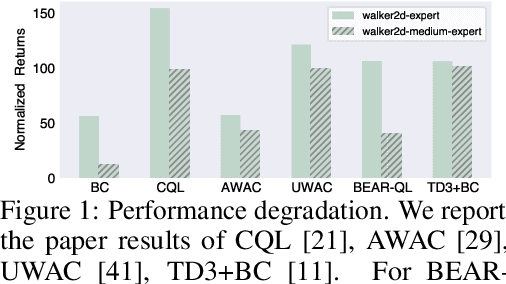
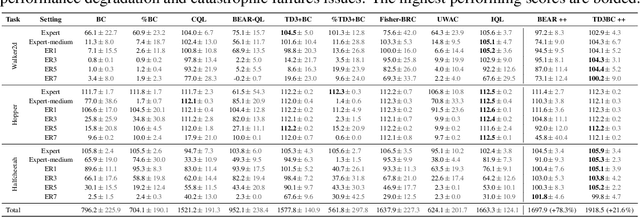

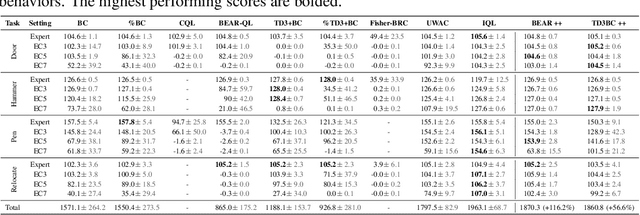
Abstract:A promising paradigm for offline reinforcement learning (RL) is to constrain the learned policy to stay close to the dataset behaviors, known as policy constraint offline RL. However, existing works heavily rely on the purity of the data, exhibiting performance degradation or even catastrophic failure when learning from contaminated datasets containing impure trajectories of diverse levels. e.g., expert level, medium level, etc., while offline contaminated data logs exist commonly in the real world. To mitigate this, we first introduce gradient penalty over the learned value function to tackle the exploding Q-functions. We then relax the closeness constraints towards non-optimal actions with critic weighted constraint relaxation. Experimental results show that the proposed techniques effectively tame the non-optimal trajectories for policy constraint offline RL methods, evaluated on a set of contaminated D4RL Mujoco and Adroit datasets.
Honor of Kings Arena: an Environment for Generalization in Competitive Reinforcement Learning
Oct 09, 2022
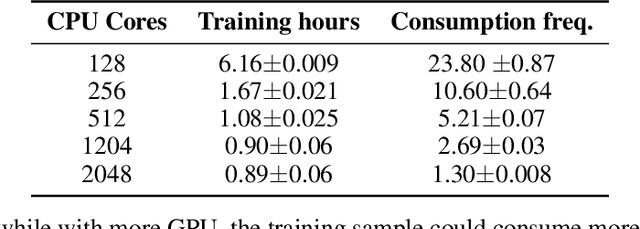
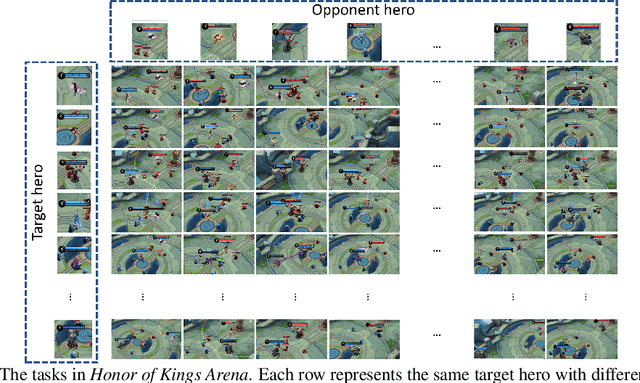
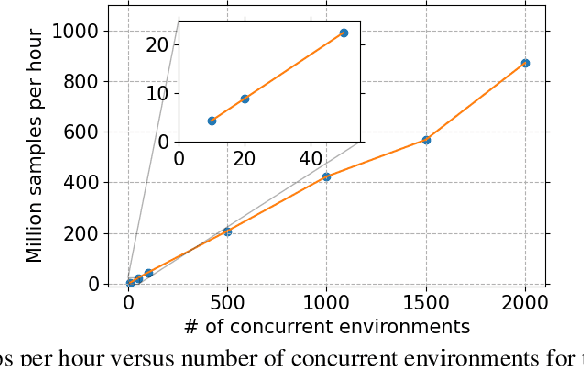
Abstract:This paper introduces Honor of Kings Arena, a reinforcement learning (RL) environment based on Honor of Kings, one of the world's most popular games at present. Compared to other environments studied in most previous work, ours presents new generalization challenges for competitive reinforcement learning. It is a multi-agent problem with one agent competing against its opponent; and it requires the generalization ability as it has diverse targets to control and diverse opponents to compete with. We describe the observation, action, and reward specifications for the Honor of Kings domain and provide an open-source Python-based interface for communicating with the game engine. We provide twenty target heroes with a variety of tasks in Honor of Kings Arena and present initial baseline results for RL-based methods with feasible computing resources. Finally, we showcase the generalization challenges imposed by Honor of Kings Arena and possible remedies to the challenges. All of the software, including the environment-class, are publicly available at https://github.com/tencent-ailab/hok_env . The documentation is available at https://aiarena.tencent.com/hok/doc/ .
More Centralized Training, Still Decentralized Execution: Multi-Agent Conditional Policy Factorization
Sep 26, 2022



Abstract:In cooperative multi-agent reinforcement learning (MARL), combining value decomposition with actor-critic enables agents to learn stochastic policies, which are more suitable for the partially observable environment. Given the goal of learning local policies that enable decentralized execution, agents are commonly assumed to be independent of each other, even in centralized training. However, such an assumption may prohibit agents from learning the optimal joint policy. To address this problem, we explicitly take the dependency among agents into centralized training. Although this leads to the optimal joint policy, it may not be factorized for decentralized execution. Nevertheless, we theoretically show that from such a joint policy, we can always derive another joint policy that achieves the same optimality but can be factorized for decentralized execution. To this end, we propose multi-agent conditional policy factorization (MACPF), which takes more centralized training but still enables decentralized execution. We empirically verify MACPF in various cooperative MARL tasks and demonstrate that MACPF achieves better performance or faster convergence than baselines.
Revisiting Discrete Soft Actor-Critic
Sep 22, 2022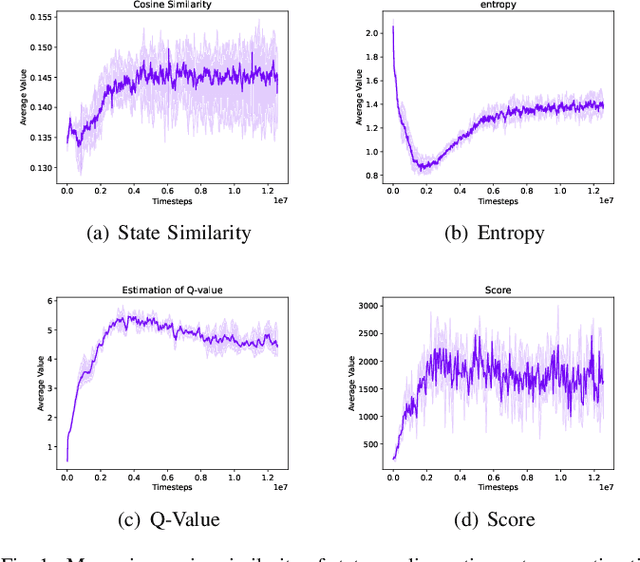



Abstract:We study the adaption of soft actor-critic (SAC) from continuous action space to discrete action space. We revisit vanilla SAC and provide an in-depth understanding of its Q value underestimation and performance instability issues when applied to discrete settings. We thereby propose entropy-penalty and double average Q-learning with Q-clip to address these issues. Extensive experiments on typical benchmarks with discrete action space, including Atari games and a large-scale MOBA game, show the efficacy of our proposed method. Our code is at:https://github.com/coldsummerday/Revisiting-Discrete-SAC.
Quantized Adaptive Subgradient Algorithms and Their Applications
Aug 11, 2022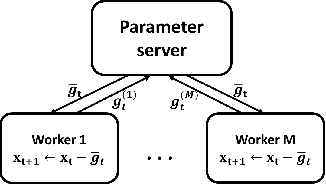
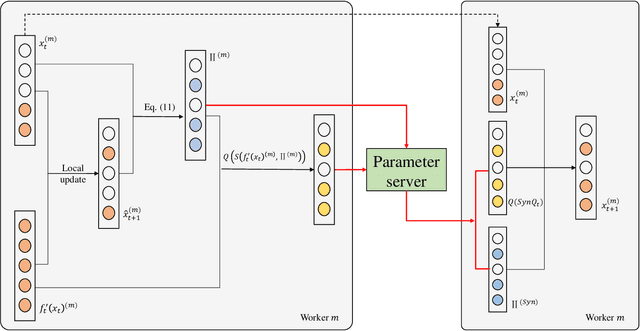
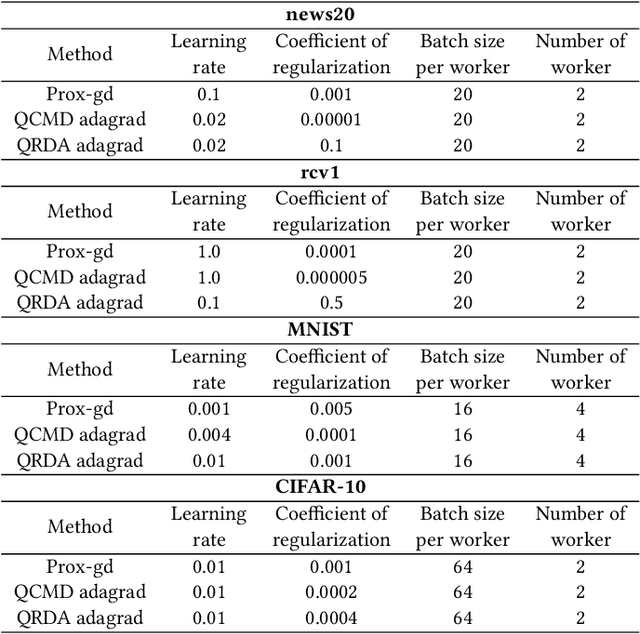

Abstract:Data explosion and an increase in model size drive the remarkable advances in large-scale machine learning, but also make model training time-consuming and model storage difficult. To address the above issues in the distributed model training setting which has high computation efficiency and less device limitation, there are still two main difficulties. On one hand, the communication costs for exchanging information, e.g., stochastic gradients among different workers, is a key bottleneck for distributed training efficiency. On the other hand, less parameter model is easy for storage and communication, but the risk of damaging the model performance. To balance the communication costs, model capacity and model performance simultaneously, we propose quantized composite mirror descent adaptive subgradient (QCMD adagrad) and quantized regularized dual average adaptive subgradient (QRDA adagrad) for distributed training. To be specific, we explore the combination of gradient quantization and sparse model to reduce the communication cost per iteration in distributed training. A quantized gradient-based adaptive learning rate matrix is constructed to achieve a balance between communication costs, accuracy, and model sparsity. Moreover, we theoretically find that a large quantization error brings in extra noise, which influences the convergence and sparsity of the model. Therefore, a threshold quantization strategy with a relatively small error is adopted in QCMD adagrad and QRDA adagrad to improve the signal-to-noise ratio and preserve the sparsity of the model. Both theoretical analyses and empirical results demonstrate the efficacy and efficiency of the proposed algorithms.
GPN: A Joint Structural Learning Framework for Graph Neural Networks
May 12, 2022
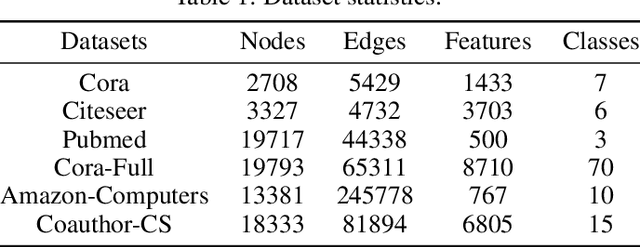
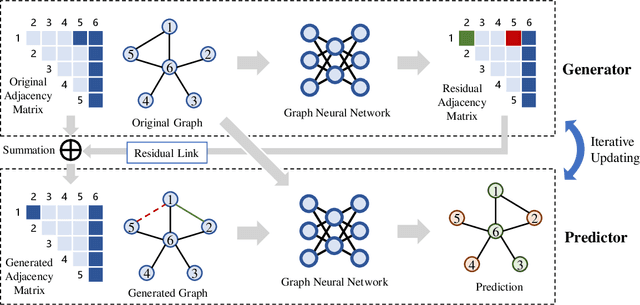
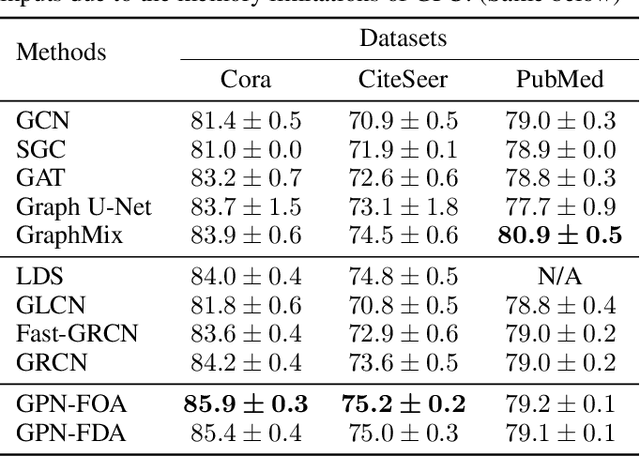
Abstract:Graph neural networks (GNNs) have been applied into a variety of graph tasks. Most existing work of GNNs is based on the assumption that the given graph data is optimal, while it is inevitable that there exists missing or incomplete edges in the graph data for training, leading to degraded performance. In this paper, we propose Generative Predictive Network (GPN), a GNN-based joint learning framework that simultaneously learns the graph structure and the downstream task. Specifically, we develop a bilevel optimization framework for this joint learning task, in which the upper optimization (generator) and the lower optimization (predictor) are both instantiated with GNNs. To the best of our knowledge, our method is the first GNN-based bilevel optimization framework for resolving this task. Through extensive experiments, our method outperforms a wide range of baselines using benchmark datasets.
MineRL Diamond 2021 Competition: Overview, Results, and Lessons Learned
Feb 17, 2022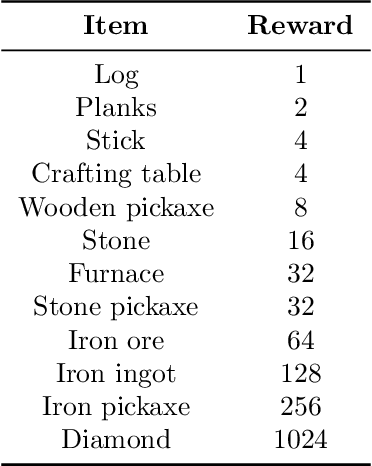
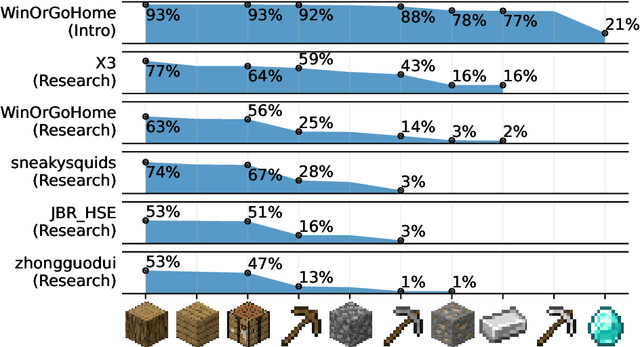
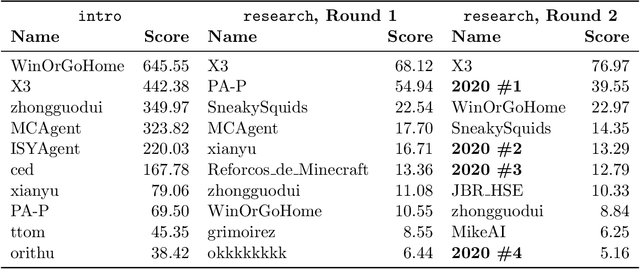
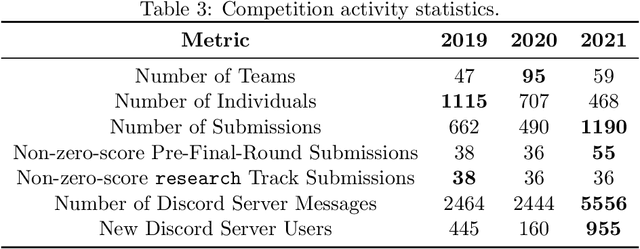
Abstract:Reinforcement learning competitions advance the field by providing appropriate scope and support to develop solutions toward a specific problem. To promote the development of more broadly applicable methods, organizers need to enforce the use of general techniques, the use of sample-efficient methods, and the reproducibility of the results. While beneficial for the research community, these restrictions come at a cost -- increased difficulty. If the barrier for entry is too high, many potential participants are demoralized. With this in mind, we hosted the third edition of the MineRL ObtainDiamond competition, MineRL Diamond 2021, with a separate track in which we permitted any solution to promote the participation of newcomers. With this track and more extensive tutorials and support, we saw an increased number of submissions. The participants of this easier track were able to obtain a diamond, and the participants of the harder track progressed the generalizable solutions in the same task.
 Add to Chrome
Add to Chrome Add to Firefox
Add to Firefox Add to Edge
Add to Edge